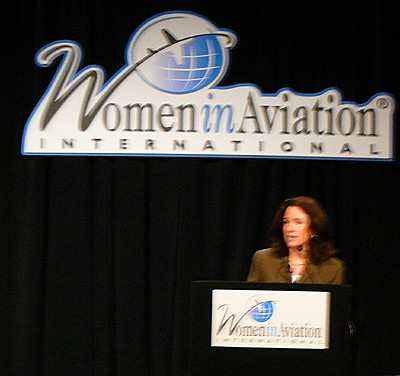Addresses Aviation's Hot Topics At Conference
With the conference theme of Imagining Your Future, day two of
the 2007 Women in Aviation, International conference featured three
women -- including airline Captain Betty Uhrig, and former NASA
astronaut and President and CEO of Seattle's Museum of Flight
Bonnie Dunbar -- who each spoke about their personal quests of
imagining their futures, and giving inspiration and encouragement
to attendees.

However, it was the second speaker -- Lisa Piccione, who came in
NBAA President and CEO Ed Bolen's stead (he was called back to
Capitol Hill) -- who also brought focus to current news about the
FAA budget, user fees, and the future of aviation.
Piccione is NBAA's senior vice president, government affairs,
and oversees the organization's legislative and political
activities involving the Administration, Congress, state, local,
and international government, and the aviation community to ensure
the safety, efficiency and acceptance of business of aviation.
As Piccione observed, the country's demand for mobility
continues to grow -- and the "system" must transform to meet the
emerging needs.
"This is an exciting time to be part of the aviation industry,"
she told the mostly female audience. "Commercial airlines are
projecting continued profits, while on the general aviation side,
new technologies, like VLJs, are under development."
General aviation alone contributes more than $150 billion to the
economy and employs more than 1.2 million people, said noted.
"General aviation provides air transportation services at more than
5,000 public use airports; for many communities, general aviation
is the only aviation option."
 Aviation issues are "front and
center" in Washington, she acknowledged, with the FAA submitting
its reauthorization proposal to Capitol Hill just last
week.
Aviation issues are "front and
center" in Washington, she acknowledged, with the FAA submitting
its reauthorization proposal to Capitol Hill just last
week.
"What that means," she said, "is that we have an opportunity
today to begin a constructive dialogue about the future of our
aviation system and focus on areas where there is broad agreement
in the industry."
Those "areas of agreement" she said, include modernization and
increasing government investment.
There is industry consensus that it must modernize, Piccione
noted. "The debate should not be about winners or losers, but
[about] building a system that can meet all future demand." She
called it a "transformation over time" that has already begun, with
new runways and a doubling in 2005 of enroute airspace with reduced
vertical minimum separations.
How to proceed? "Government and industry must identify the
technologies, timelines, and costs of the next phase of the
transformation."
Piccione called upon WAI members to be critical leaders in
efforts to increase the government's investment in aviation through
a strong general fund contribution.
Pointing to the critical role that aviation plays in every
community, including national defense, emergency response, medical
emergencies, postal service, local and interstate commerce, she
said "we all must work harder than ever" with elected officials to
remind them of the national importance of a strong aviation system
and request an increase in the federal government investment in
aviation.
With aviation funding coming from two revenue sources, the
airport and the airway trust fund, which is funded through aviation
taxes, Piccione noted that over the next several months, the
general aviation community will be talking about the importance of
Congressional oversight.
"We believe that the US Congress is in the best position to
balance the competing interests and ensure that we continue to have
the best system in the world," she said. "And thanks to
congressional support, FAA funding has increased despite the
challenges faced by the industry and the economy."

If we are going to meet the challenges of the future, Piccione
said, we should focus our collective energy on the things that
bring us together.
"Aviation is a vital national asset, and each of you will be a
key player in determining the future of our industry."
 ANN's Daily Aero-Linx (05.06.25)
ANN's Daily Aero-Linx (05.06.25) ANN's Daily Aero-Term (05.06.25): Ultrahigh Frequency (UHF)
ANN's Daily Aero-Term (05.06.25): Ultrahigh Frequency (UHF) ANN FAQ: Q&A 101
ANN FAQ: Q&A 101 Classic Aero-TV: Virtual Reality Painting--PPG Leverages Technology for Training
Classic Aero-TV: Virtual Reality Painting--PPG Leverages Technology for Training Airborne 05.02.25: Joby Crewed Milestone, Diamond Club, Canadian Pilot Insurance
Airborne 05.02.25: Joby Crewed Milestone, Diamond Club, Canadian Pilot Insurance





